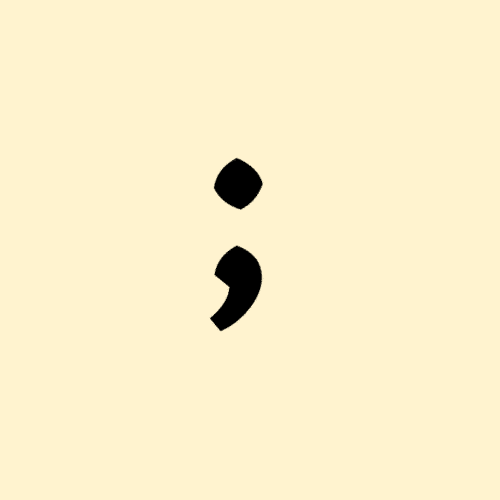“Pretentious”; “ugly as a tick on a dog’s belly”; “transvestite hermaphrodites representing absolutely nothing”—what unfortunate grammatical phenomenon has been the object of such derision? The answer is hidden in plain sight in the sentence itself, in the form of the marks separating each insult: the semicolon.
By Nick, a Berlin-based writer and editor.
Ever since it first appeared in a fifteenth-century Venetian treatise on volcanoes (De Aetna, by a certain Pietro Bembo), this hybrid creation, this “drooping mustache with a gamey taste” (as Theodor Adorno memorably described it), has been called out as an impostor, its membership in the pantheon of punctuation a matter of fierce contestation. How can this be, given that Moby-Dick, the novels of Henry James, and the sentences of writers as disparate as Marcel Proust and Raymond Chandler, to name just a few examples, are all inconceivable without their masterful manipulation of the semicolon? Why has such a basic tool in the prose arsenal had its very right to exist questioned by so many?
A big reason, writes Cecilia Watson in Semicolon, is that “the semicolon is a place where our anxieties and our aspirations about language, class, and education are concentrated.” A whiff of snobbery has long clung to it. “All they do is show you’ve been to college,” runs the rest of the Kurt Vonnegut quote about “transvestite hermaphrodites” cited above. It hasn’t helped matters that some have embraced the semi precisely as a shibboleth of linguistic sophistication. Claimed one fin-de-siècle Englishman: “The simplest method of isolating the masters of modern English literature is carefully to observe the frequency and propriety of their semicolons.” Indeed?
The semicolon has also been accused of enabling logical laxity. The intellectual historian Paul Robinson laments how it is more often than not used to “gloss over an imprecise thought” by “plac[ing] two clauses in some kind of relation to one another but reliev[ing] the writer of saying exactly what that relation is.” An extreme semicolonophobe, Robinson feels “morally compromised” when he uses it, pining instead for the relative purity of periods and commas.
The lack of a clarifying conjunction to make explicit the relation between the two independent clauses it separates would seem to be the source of Robinson’s unease with the semicolon. Not for him the pregnant pause embedded in this schoolbook example from Strunk & White: “It is nearly half past five; we cannot reach town before dark,” with its hint of crepuscular mystery. Rather: “It is nearly half past five, and we cannot reach town before dark.” Okay, then; got it.
Last but not least, the semicolon has often been faulted for its seeming lack of a coherent identity, its frustratingly ambiguous in-betweenness: more emphatic than a comma but with nothing of the colon’s bullhorn assertiveness. And, as evidenced by Vonnegut’s tasteless-by-21st-century-standards crack, such concerns can also bleed into anxieties over one’s linguistic virility—but that’s another story. Its use in legal language has led to many controversies in which entire cases hinged on its precise meaning; one nineteenth-century newspaper wondered incredulously how so much statutory confusion could arise over the “inability to fix the proper function of the semicolon.”
Profound Punctuation
So much for the case against. The defense rests with a brief nod to Adorno, whose philosophical justification of the semicolon in his essay “Punctuation Marks” is more than a match for all the foregoing kvetching. Adorno equated suspicion of the semicolon with suspicion of complex thought; such writerly ideals as “lucidity, objectivity, and concise precision” were for him ideologies invented by capitalism in order to justify the market’s coddling of readers made impatient by the baubles of modern society. Doing away with complicated sentences containing several balanced clauses—the sort in which the semicolon often plays a starring role—“leaves the idea short of breath”; before you know it, “prose is reduced … to a mere recording of facts.”
In other words: The stakes are high, dear reader! Ugly, snooty, obfuscatory, the semicolon might nevertheless just save, if not your soul, then at least your sensibility. Adorno: “It starts with the loss of a semicolon; it ends with the ratification of imbecility.”

